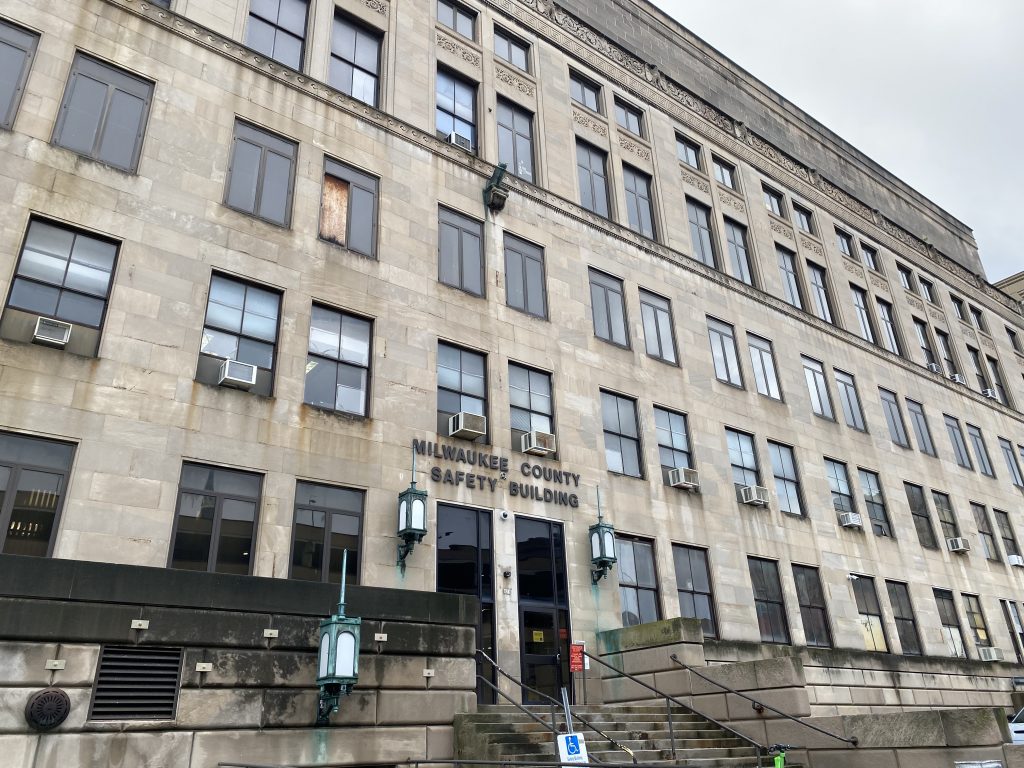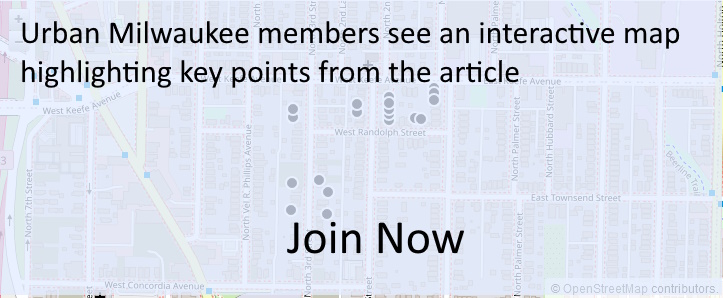Could Courthouse Project Forge Partnership With State?
Discussion by county, state officials suggests political opening for state funding.

Milwaukee County Safety Building. Photo by Graham Kilmer.
The new Milwaukee County Criminal Courthouse project is being heralded as the biggest public works project in county government history, but it might also end up being one of the most important political deals between the county and the state in local history.
The project, which could cost as much as $500 million, has some support on both sides of the state Capitol. The plan is to demolish the Safety Building, 821 W. State St., where a majority of criminal cases are tried, and build a new criminal courthouse. The building does not meet the needs of a courthouse and actually hampers the local circuit court system, according to court officials.
The county faces significant budget shortfalls in the near future, and it’s seeking approximately $250 million in state support for the courthouse project. Without state support, if the county has to borrow for the project on its own, the interest on the debt has been estimated at approximately $300 million, according to Crowley.
As the county has nudged the project forward in recent years, a political opening has formed to provide state funding for the courthouse project in a deal that would also address some of the county’s longstanding financial challenges. That could include funding the project as part of a larger restructuring of state judicial funding, as well as providing greater state funding support for the raft of programs and services state law requires counties to administer.
A handful of key state and county officials offered a glimpse at the thinking at both levels of government on the issue during a panel Monday hosted by the Wisconsin Policy Forum at Potawatomi Hotel and Casino.
The panel included County Executive David Crowley, Chief Judge Carl Ashley, Milwaukee County District Attorney Kent Lovern, Republican State Rep. Bob Donovan and Republican State Senator and Senate president Mary Felzkowski.
Both Felzkowski and Donovan support providing state funding for the project. Felzkowski, who represents northeastern Wisconsin along the border with Upper Peninsula Michigan, told the packed room in Milwaukee, “I, personally, am 100% behind the state helping replace the public safety building.”
Felzkowski noted the county’s $250 million request could be parceled out over more than single budget, making it an easier pill for state legislators to swallow. “So I think this is very doable, but it’s got to be creative,” she said.
In the context of the conversation Monday, “creative” referred to providing state funding for the courthouse project in ways other than simply writing Milwaukee County a check.
Crowley laid out some potential creative ways to fund the project. The state could let the county collect a greater share of circuit court fees, the majority of which go to the state. It could provide greater funding expressway patrols by the Milwaukee County Sheriff’s Office (MCSO). Milwaukee is the only county that has to patrol its own freeways, and it currently covers more than 90% of the roughly $14 million it costs annually. There’s also the prospect of greater state support for the county’s Community Reintegration Center, a county correctional facility that costs more than $60 million a year to run.
“We’re not saying that we want to give up our responsibilities,” Crowley said. “What we’re asking for is there a way to help get some relief as it relates to some of the mandated programs that we have to actually serve.”
Any funding in these areas would free up dollars for the county to put towards servicing the debt it will need to issue to pay for the courthouse project. It would also, in the long run, help the county tamp down its structural budget deficit.
“There is a recognition that some of the mandates that exist for Milwaukee County, the state needs to step up and help fund those a little better,” Donovan said.
Despite her support for the project, Felzkowski was less receptive to the concept of unfunded state mandates, “I would agree with what Bob said, but I would also remind people that counties exist statutorily to carry out the work of state government.”
Felzkowski was an author of Wisconsin Act 12, which gave the Milwaukee County authority to levy a new 0.4% sales tax as part of a restructuring of state aid for local governments that included a side deal to pay off and eventually close out the county’s out-of-control-pension system. During her work on Act 12 she toured the Safety Building while learning more about Milwaukee.
The “crumbling, aged, obsolete” building, as Chief Judge Ashley explained Monday, does not meet the standards for a criminal courthouse. It forces members of the public, defendants, jurors, victims, witnesses, law enforcement, judges and attorneys to all use the same hallways to access the court rooms. “Mingling those groups is dangerous” he said, and has at times led to mistrials that further delay and tax the system.
The Safety Building is part of a courthouse complex that includes the historic Milwaukee County Courthouse and the county jail, called the Criminal Justice Facility. The county’s plan is to completely replace the safety building and make improvements to the two other facilities.
“None of the buildings were built to house criminal courts, which require extra layers of security, extra layers of private hallways, extra meeting spaces,” District Attorney Lovern said. “None of the three buildings… are conducive to that at all, and we have criminal courts in all three of those buildings.”
The new courthouse would make the system faster and more efficient to run, the county panelists noted. Persons in custody would spend less time in the jail; the circuit courts would need fewer bailiffs to transfer defendants in-custody; and a modern building would be cheaper and more efficient to run, potentially saving more than $1 million a year in energy costs.
County officials are also pushing the project with a sense of urgency. The county has been considering replacing the Safety Building in some way for nearly two decades, as Rob Henken, immediate past president of the policy forum noted. The cost has ballooned since the early estimates, and now county officials expect the project cost to expand as much as $100 million each year the project is put off, Crowley said. That’s due to cost-inflation and compound interest on debt associated with the rising cost, according to Aaron Hertzberg, director of the county Department of Administrative Services.
But the county still has more state legislators to convince. Felzkowski said legislators from other parts of state recognize the importance of Milwaukee and its importance to the rest of Wisconsin: “It’s a symbiotic relationship.”
Donovan, however, suggested the political relationship between Milwaukee and other parts of the state was more fraught. “Okay, I agree with you, however, I would urge you to sit in on one of my caucus meetings,” Donovan said. “You might walk away with a different opinion. But God bless you Mary. I wish everyone was like you.”
With the sales tax deal and the Brewers stadium funding bill both passed during the last session, Felzkowski said, rural legislators are less interested in more major “Milwaukee-focused” legislation. Felzkowski did, however, indicate she believes the state needs to rethink judicial funding across the board. “We probably really should do a deep dive into how we’re funding our court system,” she said. “I’m hearing that loud and clear statewide.”
Wisconsin Act 12 was bolstered by a statewide call for changes to state funding for local governments. And, once again, Milwaukee’s requests to Madison are starting to overlap with those issuing from other communities across the state. Waukesha County also has a plateful of unfunded state mandates and the county supervisors there have recently begun calling on the state to relieve some of the financial burden.
The reception at the state Capitol to the county’s courthouse pitch has been “positive” so far, Crowley said. The county executive is framing the courthouse project not as a local funding request, but a deepening of the “partnership” between the state and the county; one developed during Act 12 negotiations, funding for the new Milwaukee Public Museum and the joint state-county Forensic Science Center.
“We have figured it out, and we’re working not only to continue to build that and build upon that foundation,” Crowley said, “but there’s a sense of trust now.”

Existing members must be signed in to see the interactive map. Sign in.
If you think stories like this are important, become a member of Urban Milwaukee and help support real, independent journalism. Plus you get some cool added benefits.
More about the New Courthouse Project
- MKE County: Despite Funding Increase, Sheriff Says Agency Is Left With Less - Graham Kilmer - Oct 16th, 2025
- MKE County: State Funding Indirectly Supporting New Courthouse Project - Graham Kilmer - Aug 28th, 2025
- MKE County: State Budget Provides Funding For Milwaukee Highway Patrol - Graham Kilmer - Jul 4th, 2025
- Nearly 160 Organizations Across Wisconsin Call for Investment in Milwaukee County Courthouse Complex - David Crowley - May 21st, 2025
- MKE County: Could Courthouse Project Forge Partnership With State? - Graham Kilmer - Apr 29th, 2025
- MKE County: Design Team Selected For $500 Million Courthouse Complex - Graham Kilmer - Jan 31st, 2025
- Milwaukee County Selects Consultants to Support Design Phase of Courthouse Complex Planning - Milwaukee County - Jan 30th, 2025
- MKE County: County Seeks Construction Manager for Its Biggest Ever Development - Graham Kilmer - Sep 27th, 2024
- MKE County: County Aims To Build New Courthouse By 2032 - Graham Kilmer - Sep 17th, 2024
- MKE County: New Courthouse Project Opens Door For Energy Efficiency - Graham Kilmer - Aug 13th, 2024
Read more about New Courthouse Project here
Political Contributions Tracker
Displaying political contributions between people mentioned in this story. Learn more.
MKE County
-
Fellow Judge Testifies in Dugan Case
 Dec 16th, 2025 by Graham Kilmer
Dec 16th, 2025 by Graham Kilmer
-
Key Questions in Dugan Trial Take Shape on First Day
 Dec 15th, 2025 by Graham Kilmer
Dec 15th, 2025 by Graham Kilmer
-
FTA Tells Milwaukee to Crack Down on Fare Evasion — Even Where Fares Don’t Exist
 Dec 12th, 2025 by Graham Kilmer
Dec 12th, 2025 by Graham Kilmer




















